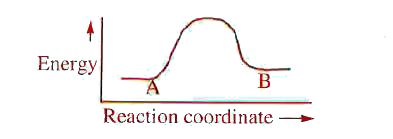Rate law for 2A+B→C+D from following data:
S.No. [A](M) [B](M) Rate(M/s)
1 0.01 0.01 2.5
2 0.01 0.02 5
3. 0.03 0.02 45 Solution in Telugu
r=K[A]1/3[B]
r=K[A]2[B]
r=K[A][B]1/3
r=K[A]2/3[B]1/3
The correct Answer is:B
Step by step video, text & image solution for Rate law for 2A+BtoC+D from following data: "S.No."" "[A](M)" "[B](M)" ""Rate"(M//s) 1" "0.01" "0.01" "2.5 2" "0.01" "0.02" "5 3." "0.03" "0.02" "45 by Chemistry experts to help you in doubts & scoring excellent marks in Class 12 exams.
Topper's Solved these Questions
- BOOK - AAKASH SERIESCHAPTER - CHEMICAL KINETICSEXERCISE - OBJECTIVE EXERCISE - 2 (Reaction rates and influencing factors)15videos
CHEMICAL KINETICS
- BOOK - AAKASH SERIESCHAPTER - CHEMICAL KINETICSEXERCISE - OBJECTIVE EXERCISE - 2 (Collision theory)2videos
CHEMICAL KINETICS
- BOOK - AAKASH SERIESCHAPTER - CHEMICAL KINETICSEXERCISE - OBJECTIVE EXERCISE - 1 (Collision theory)14videos
CHEMICAL KINETICS
- BOOK - AAKASH SERIESCHAPTER - CHEMICAL KINETCSEXERCISE - EXERCISE - 3.245videos
CHEMICAL KINETCS
- BOOK - AAKASH SERIESCHAPTER - CHEMICAL THERMODYNAMICSEXERCISE - Additional Practice Exercise54videos
CHEMICAL THERMODYNAMICS
Similar Questions
Consider the following reaction N2(g)+3H2(g)→2NH3(g). The rate of the reaction in terms in terms of N2 at T(k) is −d[N2]dt=0.02 mole lit−1sec−1. What is the value of −d[H2]dt (in mole lit−1sec−1) at the same temperature?
02:43View SolutionThe minimum energy required for molecules to enter into chemical reactionn is called
02:20View SolutionFor a reversible reaction, A⇔B, which one of the following statements is wrong from given energy profile diagram ?
 04:10View Solution
04:10View SolutionDiscuss on the kinetic spontaneity of a chemical reaction. Is a slow reaction spontaneous? Why?
02:02View SolutionWhich among the following is not an exact differential?
View SolutionIf L = (20 +- 0.01) m and B = (10 +- 0.02)m then L//B is
06:02View SolutionIf L_(1) = (2.02 +- 0.01)m and L_(2) = (1.02 +- 0.01)m then L_(1) + 2L_(2) is (in m)
01:23View SolutionWhat is [NH_(4)^(+)] in a solution that contain 0.02 M NH_(3)(K_(b)=1.8xx10^(-5)) and 0.01 M KOH?
02:30View SolutionThe rate of the first reaction A to products is 0.01 M//s , when reactant conentration concentration is 0.2 M . The rate constant for the raction will be
03:17View SolutionFor a given reaction, Ararr"Product, rate is" 1xx10^(-4)"M s^(-1) when [A] = 0.01 M and rate is 1.41xx10^(-4)"M s"^(-1) when[A] = 0.02 M. Hence, rate law is :
02:53View SolutionArrange the following solutions in the decreasing order of pOH : (A) 0.01 M HCl (B) 0.01 M NaOH (C) 0.01 M CH_3 COONa (D) 0.01 M NaCl
04:21View SolutionIfL=(20±0.01)mandB=(10±0.02)m then L-B is
03:56View SolutionIf L = (40 + 0.02) m and B = (20 +0.01) m then L/B is
(A) (2 +0.003) m (B) (2 +0.015) m (C) (2 + 0.01) m (D) (2 +0.002) mView SolutionIf L=(20±0.01)mandB=(10±0.02)m then L/B is
03:17View SolutionRate law for 2A+B→C+D from following data:
S.No. [A](M) [B](M) Rate(M/s)
1 0.01 0.01 2.5
2 0.01 0.02 5
3. 0.03 0.02 4501:58View Solution
